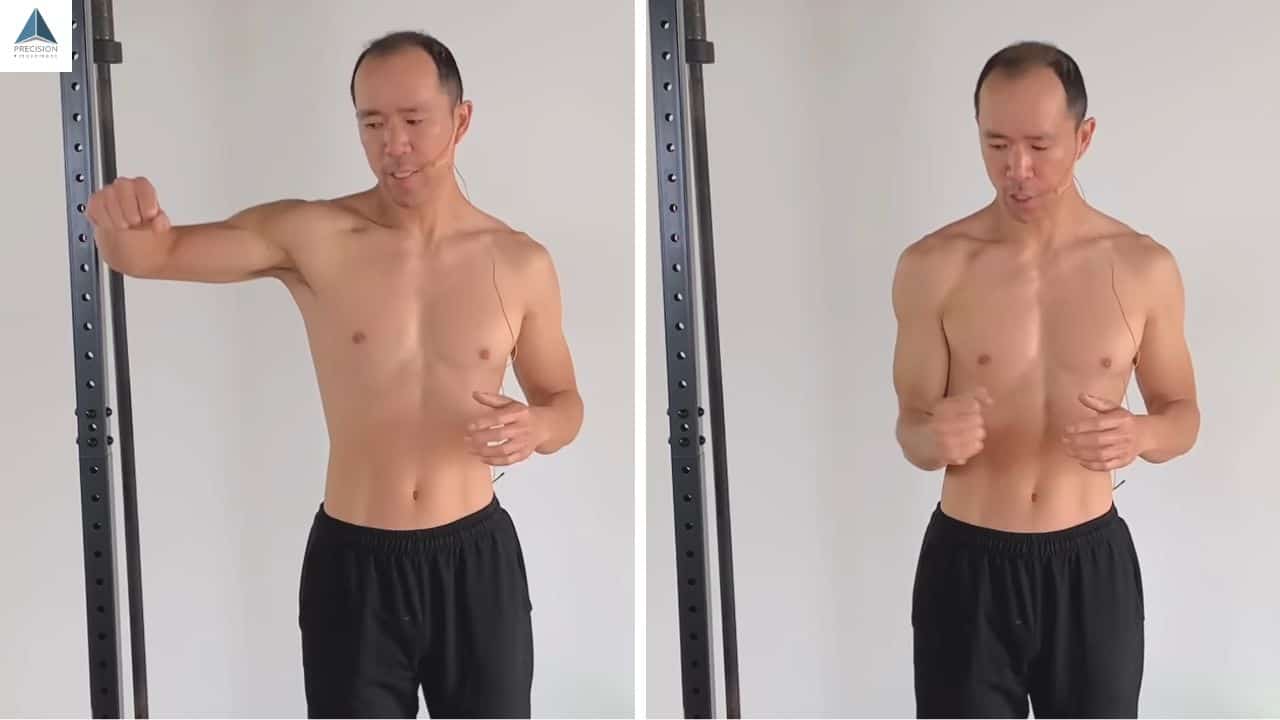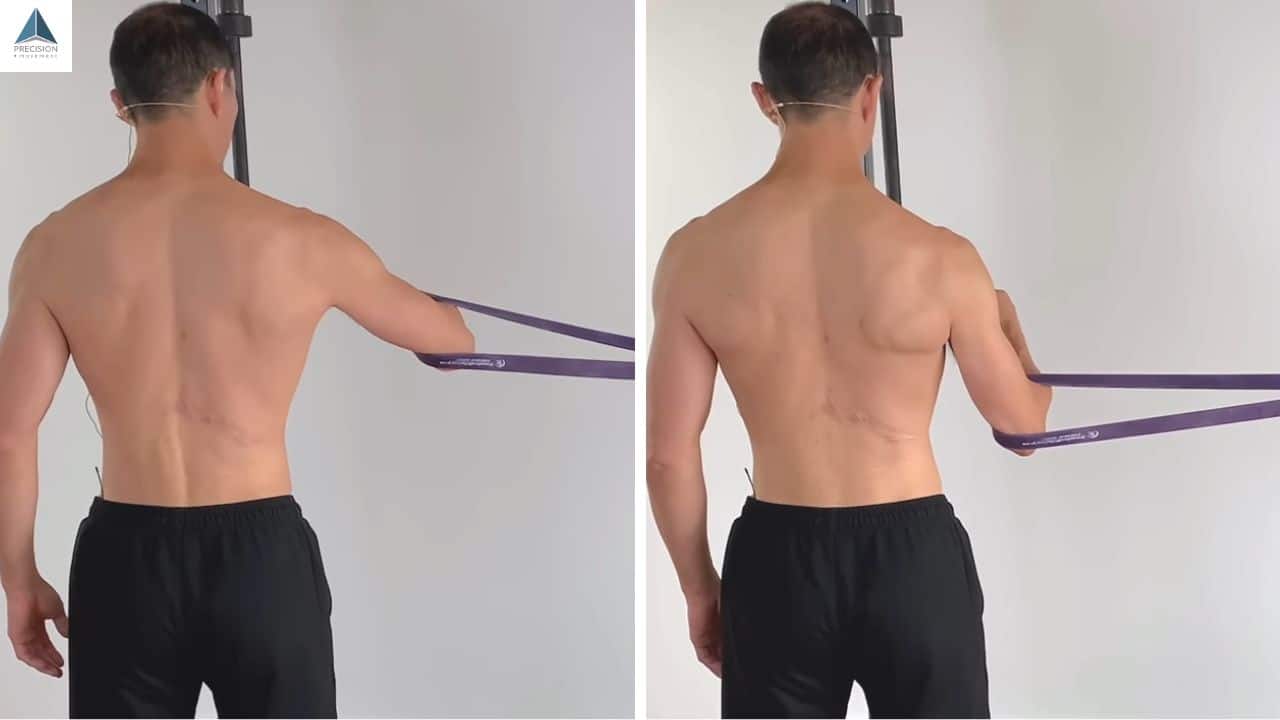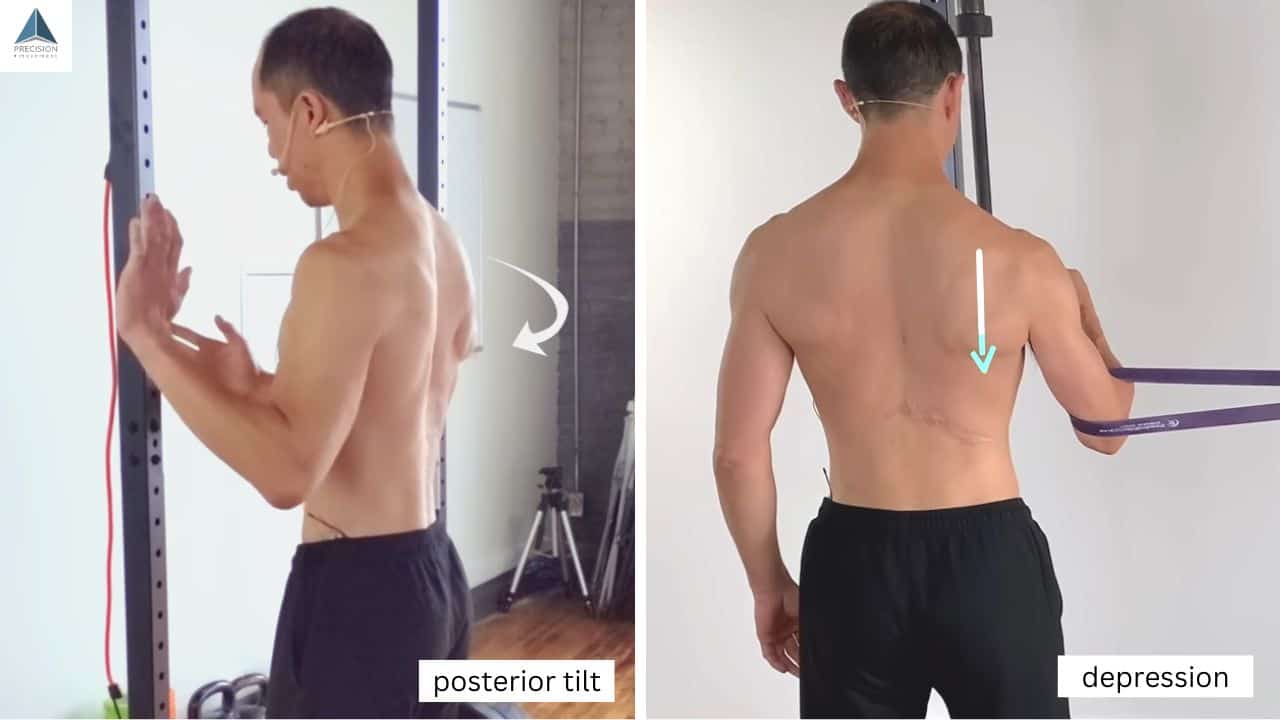
If you have shoulder pain, this exercise for lower trapezius activation will correct a common imbalance that’s found in the upper trap muscle. You’ll learn to restore balance to your shoulder.
First, we’ll dive into some anatomy so you understand the mechanics of your shoulder, then we’ll cover this easy, couple-minute exercise.
You can also follow along with our YouTube video on this lower trap/infraspinatus exercise: Shoulder Pain? Infraspinatus & Lower Trapezius Exercise.
Upper & Lower Trapezius Mechanics
A common finding with shoulder pain is that the upper trapezius muscle is overactive compared to the lower trapezius.
Researchers looked at the importance of a strong balance between the upper and lower traps. [1]
It turns out that most therapists understand and treat this imbalance. However, the exercises used to get the lower trapezius firing require the ability to lift your arms over your head or at least 90 degrees.
If you have shoulder impingement (or poor scapular function where the scapula is anteriorly tilting), it hurts to get your arm up over your head. It becomes that much harder to stick with the rebalancing practice because most people don’t get excited about doing exercises that hurt.
(Anterior tilt means the top of something leans forward. In the case of your scapula, if you balanced a glass of water on your shoulder, an anterior tilt would spill it down your front.)
Read more here on exercises for shoulder impingement pain relief.
The exercise in this article takes advantage of a phenomenon known as reciprocal inhibition. When you activate one muscle, the opposing (or antagonistic) muscle group shuts off.
That’s exactly what we’re going to do. You will shut off the upper trapezius.
How are you going to do that?
When you bring your elbow towards your body, out from 90 degrees or more, that’s adduction.
You get muscles firing like the teres major, the lats, or even the pecs. They all contribute to adduction, shutting off the opposing muscle groups, including the upper trapezius fibers.
The upper trapezius takes responsibility for abduction, lifting your arm up overhead.
(Sometimes, pain lifting your arm overhead can be from rotator cuff issues, read more on how to rehab a strained rotator cuff here.)
So we’re going to inhibit the upper trapezius by adducting. Then we’ll perform an exercise to get the trapezius turned on, which is retraction.
This exercise is really important, and it’s the one I stumbled across when I was doing some literature review for a new program we released called Shoulder Pain Solution.
This study shows that adding adduction helps to decrease upper trapezius tension and helps to increase the lower trapezius and infraspinatus activation, which is another muscle that benefits shoulder stability. It helps to reduce shoulder pain by restoring proper function, and I’ve just added the little piece with depressing the scapula. [2]
How? It’s easy.
Infraspinatus & Lower Trap Exercise
You can use a strength band setup if you have one. But don’t get hung up on the equipment. We’ll cover alternatives if you don’t have one.
The key, regardless of your equipment, is getting the adduction force going when you do the movement.
- Wrap the resistance band around your bicep just above the elbow
- Step away from the anchor for a little bit of force (50-60%)
- Retract the shoulder blade by squeezing shoulder blades together
- Hold for 5 seconds
- Slowly relax
Breathe throughout the whole exercise. Many people forget and hold their breath while activating muscles, especially before they get used to performing an exercise.
Once you get the hang of it, try the tier-two version.
Focus on posterior scapular tilt too. Pull the bottom edge of your shoulder blade into your body while holding for the 5 seconds.
(If you need a refresher on posterior tilt, head over to this YouTube video for a more in-depth explanation.)
The third tier focuses on depressing the shoulder blade down toward the floor. This depression further shuts off the upper traps. Get it as flush to the ribcage as possible.
Repeat for 6-8 reps and switch sides. Start with two sets. After that, progress your way up to three sets and ten reps.
If you do this exercise two to three times a week for four weeks, you should have built up some endurance and strength in that lower trapezius muscle. You’ve shut off the upper trapezius muscle, and then movement overhead should become less painful.
We’re getting a lot of little nuances in there, the depression of the serratus anterior with the posterior tilt. Focus on that cue of depression and posterior tilt because the serratus anterior is really important for shoulder stability and proper alignment – dynamic alignment as you’re moving your shoulder around. We’re getting a lot of little elements that contribute to healthy movement and function of the shoulders.
Read more here on the top 3 exercises to strengthen your serratus anterior.
When the movement patterns are clean, the shoulders are going to be less painful, or ideally, not painful at all.
What if you don’t have a resistance band?
Let’s address the equipment thing.
We get a lot of emails and comments on YouTube asking, “what band are you using? What size exactly? Where can I buy it?”
The equipment here is not the key. If you have a resistance band handy, great! But if you don’t, a bungee cord works just as well. Just wrap it around the same anchor you would use for a resistance band.
Don’t have a bungee cord either? Do you have pants? Great!
Wrap your spare pants (even if you’re doing the exercise in your underwear) around an anchor point, tie the legs together, and use that as resistance. They don’t even have to be stretchy pants.
The resistance will still allow the adduction to shut off the upper traps. You’ll get the same benefits as a resistance band.
Use whatever you’ve got handy. You don’t need to have the perfect equipment. Apply the fundamental concepts, and you will get the benefits.
So do that exercise. There are different ways with different pieces of equipment that you can use, so there are no excuses not to do this technique because it can be really, really helpful. Even if you have neck pain because you’re stressed, the upper traps hold tension. Try this technique to decrease upper trap activation and help to restore a relaxed and properly aligned shoulder girdle.
There you have it! I hope you enjoyed the article and add this to your exercise routine if you have shoulder pain. Try it out!
—
This article was reviewed and updated on November 8, 2022 by our Chief Medical Officer, Dr. Erin Boynton, MD, FRCS to include new research and information on latest surgical developments. Read more about Dr. B here.




